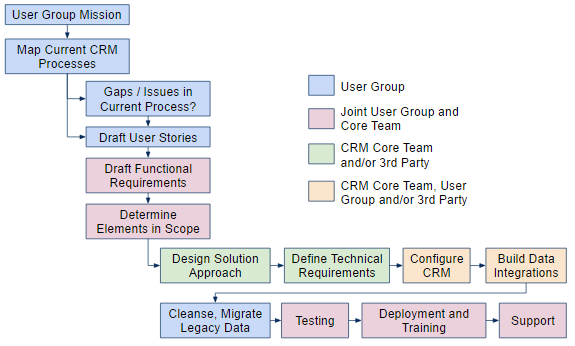Getting Started
Each user group will play a critical role in successfully moving through the requirements definition, configuration, testing, training and deployment phases of Notre Dame’s enterprise crmND deployment.
Below are descriptions of roles and responsibilities and process steps that will support a successful crmND deployment.
Identify User Group Project Champion
This individual is critical to the success of a crmND deployment and provides support is the following ways.
- Financial - Allocates funding for software licenses, configuration / integration support from a preferred implementation partner, and Power User / Local Administrator Salesforce training
- Personnel - Assigns Power User(s) / Local Admin(s) and subject matter experts to their CRM project team for requirements gathering, testing and training
- Working Group Representative - Participate in the Working Group to represent user needs and collaborate with the CRM core team and other Champions regarding enterprise issues
High-Level View of Requirements Definition and Deployment Process
(More details are provided for each step below)
- Review and document user group mission
- Identify and map CRM processes
- Define user stories
- Define functional requirements
- Determine scope
- Design Solution
- Define technical requirements
- Configure Salesforce CRM
- Cleanse, Migrate, and Integrate Legacy Data
- Testing
- Deployment and Training
crmND Requirements Definition and Deployment Process Overview

Review and Document User Group Mission
The purpose of this step is to capture the mission of the user group as a high-level narrative. Narratives should be added for each area within the larger user group to to illustrate how these areas align and support the larger mission.
Identify and Map CRM Processes
Identify and document user group process related to managing relationships with external constituents (alumni, parents and friends). Capture the current state to clarify who is doing what, identify data that is captured (source and storage method), and how information generated from the processes are utilized (i.e. reporting). It is recommended that Green Belts or other individuals from the user group skilled in facilitating and process mapping support effort. A Visio template has been developed to support capturing this information in a consistent manner. (CRM Process Mapping Template - VISIO file template)
Next, evaluate these maps and identify pain points, gaps and issues. Surface items that, if resolved, could make your process more efficient and effective. (Current State Key Gaps Root Cause Proposed Solutions Template)
Each user group should document legacy CRM data that may exist in spreadsheets, databases or other CRM systems that will need to be cleansed, matched, transformed, loaded and/or integrated with crmND. Identification of these data sources and fields will impact the configuration of crmND and define required integrations.
Future process maps will be developed once the scope of the deployment for your area is defined and crmND is configured. These future state maps will support crmND training and adoption in your area.
Define User Stories
As a follow-on to the narrative and Business Process Mapping effort, the team will be primed to define user stories that describe requirements for their crmND processes. A user story is a tool used in Agile software development to capture a description of a feature from an end-user perspective. The user story describes the 1) type of user, 2) what they want and 3) why. A user story helps to create a simplified description of a requirement. (CRM Requirements Traceability Matrix Template)
Start with the end in mind...what information / output is needed to support the process? User Stories should be technology agnostic, cover current business requirements and describe a future state that would result in a more efficient and effective process.
Define Functional Requirements
A functional requirement defines a function of a system or its component. A function is described as a set of inputs, the behavior, and outputs.
Determine Scope
The CRM Core Team will analyze the user stories and functional requirements to determine what functionality already exists in crmND. The user group and the CRM Core Team will review requested functionality that does not currently exist to determine what will be in scope for this deployment and what items may be part of a follow-on deployment.
The finalized scope will be used to estimate the implementation cost that will be supported by the user group which may include the following elements.
- Basic Salesforce licensing costs for each user
- Licensing costs for additional functionality (i.e. Pardot, Marketing Cloud, Social Studio, etc.)
- Administrator training for Power Users / Local Administrators
- Preferred Implementation Partner requirements analysis, configuration and/or data integration work